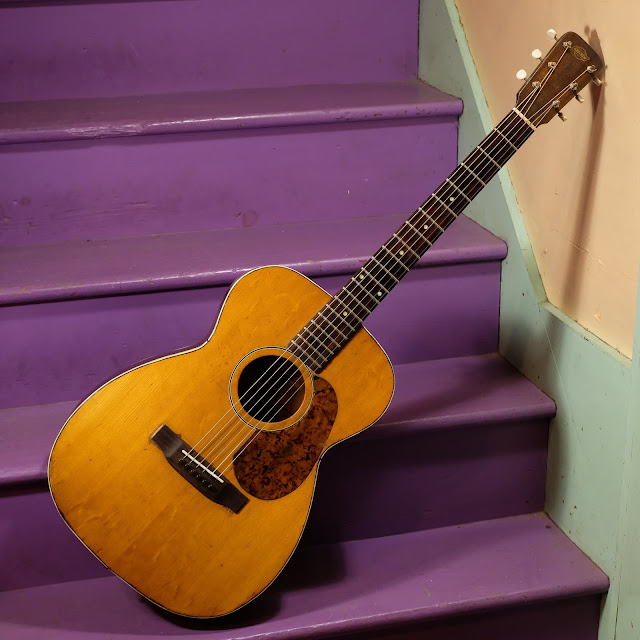1953 Gretsch 6003 "Jimmie Rodgers" 00-Size Flattop Guitar
Oh man, another Gretsch 6003? I just recently got-back one I sold in 2014 and now this guy's on my doorstep. I'm not complaining, though -- I like old Gretsch flattops. They've got down-to-earth looks and pricing, but they sure kick it where it counts. They're also built like tanks so they survive typical wear and tear pretty well, too.
Compared to the last couple 6003s I've worked on, this one is in the earlier style and has a non-truss neck and ladder-bracing rather than x-bracing. Ironically, it's a lot louder and woodier than the x-braced variety (well, this particular one is) and it has a Gibson LG-1 sort-of voice but on steroids and perhaps mixed with a little Harmony H1203 in there. Because it has such a warm/not-zippy bottom, it could be mistaken for an x-braced instrument, though. It's really got an interesting sound.
This one came in the shop and is part of a trade-for-work deal I've got going to fix an old '30s Gretsch archtop to its fullest. I worked on this one while I was going-about getting that one ready. Suffice to say, this one needed less work and is done before its stablemate. I've gotta say -- there's a lot going for this guitar -- the neck is comfortable and has a mid-'50s, Gibson-like C-shape, it has bigger frets, the sound lets you drive it in a choppy archtop way but then also in a chordal, flattop-style way, and it's beat-up enough that it feels like some lived-in shoes. It's friendly.
Work included: a neck reset, fret level/dress, tons of cleaning, minor binding and pickguard reglue work, a replacement bridge, new bone saddle, new bridge pins and endpin, and a good setup. It has long scale and a non-truss (well, it's a non-adjustable truss, anyway) neck, so I kept the gauges conservative at 50w, 38w, 28w, 22w, 16, 12. I think a more-straight set of 11s (50w-11) would probably be just about perfect for it in standard tuning. I don't think it's wise to tease the neck with a regular 54w-12 set, though. It plays spot-on with 3/32" EA and 1/16" DGBE at the 12th fret. The neck adds just a tiny amount of relief (~1/64") overall tuned to pitch, which is just about the same as your average non-adjustable-truss Martin of the '60s or '70s.
Scale length: 25 1/2"
Nut width: 1 3/4"
String spacing at nut: 1 1/2"
String spacing at saddle: 2 1/16"
Nut width: 1 3/4"
String spacing at nut: 1 1/2"
String spacing at saddle: 2 1/16"
Body length: 18 7/8"
Lower bout width: 14 1/4"
Upper bout width: 10 3/4"
Lower bout width: 14 1/4"
Upper bout width: 10 3/4"
Waist width: 8 3/4"
Side depth at endpin: 4"
Top wood: solid spruce
Back/sides: ply mahogany
Neck wood: mahogany
Fretboard: rosewood
Back/sides: ply mahogany
Neck wood: mahogany
Fretboard: rosewood
Neck shape: ~8" radius fretboard w/slim-to-medium C rear
Bridge: rosewood
Nut: original bone
Saddle: new bone
Condition notes: there's plenty of wear and tear throughout, but no cracks. The guitar is also all-original save the new bridge, saddle, and pins. The original pickguard looks ace. There are gaps in the binding here and there where it split and was reglued -- these are a non-issue. Gretsch binding tends to shrink and do weird stuff over time. I'm thankful that this stuff is actually in such good shape.
The original jumbo-ish frets are on the lower side but still have plenty of life to live.
The spruce top has some really cool "bearclaw" figure on the lower bout.
The back and sides are somewhat-heavy, 3-ply mahogany. It means the bodies are stable, though!
Someone was arguing with me about whether the sides were ply or not on these years ago. They are ply. Just remove the endpin and you can see the 3 layers that make up the ply of the side material.
I like the old tuners. They work just fine, too.
I added the relic'd strap button. I needed to see how this looked on me with a strap, right? Always useful.
The 7250 serial places it at '53.






















Comments